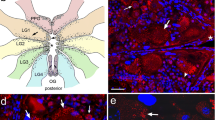Summary
The distribution of FMRFamide-like immunoreactive neurons in the nervous system of the slug Limax maximus was studied using immunohistochemical methods. Approximately one thousand FMRFamide-like immunoreactive cell bodies were found in the central nervous system. Ranging between 15 μm and 200 μm in diameter, they were found in all 11 ganglia of the central nervous system. FMRFamide-like immunoreactive cell bodies were also found at peripheral locations on buccal nerve roots. FMRFamide-like immunoreactive nerve fibres were present in peripheral nerve roots and were distributed extensively throughout the neuropil and cell body regions of the central ganglia. They were also present in the connective tissue of the perineurium, forming an extensive network of varicose fibres. The large number, extensive distribution and great range in size of FMRFamide-like immunoreactive cell bodies and the wide distribution of immunoreactive fibres suggest that FMRFamide-like peptides might serve several different functions in the nervous system of the slug.
Similar content being viewed by others
References
Belardetti F, Kandel ER, Siegelbaum S (1987) Neuronal inhibition by the peptide FMRFamide involves opening of S K+ channels. Nature 325:153–156
Boer HH, Schot LPC, Veenstra JA, Reichelt D (1980) Immunocytochemical identification of neural elements in the central nervous system of a snail, some insects, a fish and a mammal with an antiserum to the molluscan cardioexcitatory tetrapeptide FMRFamide. Cell Tissue Res 213:21–27
Brezina V, Eckert R, Erxleben C (1987) Modulation of potassium conductances by an endogenous neuropeptide in neurones of Aplysia californica. J Physiol 382:267–290
Callaway JC, Masinovsky B, Graubard K (1987) Co-localisation of SCPB-like and FMRFamide-like immunoreactivities in crustacean nervous systems. Brain Res 405:295–304
Cardot J, Fellman D (1983) Immunofluorescent evidence of an FRMFamide-like peptide in the peripheral nervous system of the gastropod mollusc Helix aspersa. Neurosci Lett 43:167–172
Chang JJ, Gelperin A (1980) Rapid taste aversion learning by an isolated molluscan central nervous system. Proc Natl Acad Sci USA 77:6204–6206
Chase R (1986) Brain cells that command sexual behaviour in the snail Helix aspersa. J Neurobiol 17:669–679
Colombaioni L, Paupardin-Tritsch D, Vidal PP, Gerschenfeld HM (1985) The neuropeptide FMRF-amide decreases both the Ca2+ conductance and a cyclic 3′,5′-adenosine monophosphate-dependent K+ conductance in identified molluscan neurons. J Neurosci 5:2533–2538
Cooke IRC, Gelperin A (1988) Distribution of GABA-like immunoreactive neurons in the slug Limax maximus. Cell Tissue Res 253:77–81
Cooke IRC, Delaney K, Gelperin A (1985) Complex computation in a small neural network. In: Weinberger NM, McGaugh JL, Lynch G (eds) Memory systems of the brain. Guilford Press, New York, pp 173–191
Cottrell GA (1983) Actions of FMRFamide and related peptides on snail neurons. In: Lever J, Boer HH (eds) Molluscan neuroendocrinology. North Holland, Amsterdam, pp 213–221
Cottrell GA, Davies NW (1987) Multiple receptor sites for a molluscan peptide (FMRFamide) and related peptides of Helix. J Physiol 382:51–68
Cottrell GA, Schot LPC, Dockray GJ (1983) Identification and probable role of a single neurone containing the neuropeptide Helix FMRFamide. Nature 304:638–640
Gelperin A (1986) Complex associative learning in small neural networks. Trends Neurosci 9:323–328
Gelperin A, Chang JJ, Reingold S (1978) Feeding motor program in Limax. 1. Neuromuscular correlates and control by chemosensory input. J Neurobiol 9:285–300
Grimmelikhuijzen CJP, Spencer AN (1984) FMRFamide immunoreactivity in the nervous system of the medusa Polyorchis pencillatus. J Comp Neurol 230:361–371
Hooper SL, Marder E (1984) Modulation of a central pattern generator by two neuropeptides, proctolin and FMRFamide. Brain Res 305:186–191
Kavaliers M, Rangeley RW, Hirst M, Teskey GC (1986) Mu- and kappa-opiate agonists modulate ingestive behaviours in the slug Limax maximus. Pharmacol Biochem Behav 24:561–566
King MS, Delaney K, Gelperin A (1987) Acetylcholine activates cerebral interneurons and feeding motor program in Limax maximus. J Neurobiol 18:509–530
Krajniak KG, Greenberg MJ, Doble KE, Price DA (1986) Localization of FMRFamide-related peptides in the slug, Limax maximus, and their effect on the isolated crop and penis. Am Zool 25:15a
Kuhlman JC, Li C, Calabrese RL (1985) FMRFamide-like substances in the leech. I. Immunocytochemical localization. J Neurosci 5:2301–2309
Lloyd PE, Frankfurt M, Stevens P, Kupfermann I, Weiss KR (1987) Biochemical and immunocytological localization of the neuropeptides FMRFamide, SCPA, SCPB, to neurons involved in the regulation of feeding in Aplysia. J Neurosci 7:1123–1132
Minnen J van, Sokolove PG (1981) Neurosecretory cells in the central nervous system of the giant garden slug Limax maximus. J Neurobiol 12:297–301
Murphy AD, Lukowiak K, Stell WK (1985) Peptidergic modulation of patterned motor activity in identified neurons of Helisoma. Proc Natl Acad Sci USA 82:7140–7144
Ocorr KA, Byrne JH (1985) Membrane responses and changes in cAMP levels in Aplysia sensory neurons produced by 5HT, tryptamine, FMRFamide and SCPB. Neurosci Lett 55:113–118
Ono JK, McCaman RE (1985) The central nervous system of Aplysia californica. A model system for cellular studies of central neurotransmission. In: Selverston A (ed) Model neural networks and behaviour. Plenum Press, New York, pp 1303–1317
Price DA (1986) Evolution of a molluscan cardioregulatory neuropeptide. Am Zool 26:1007–1015
Price DA, Greenberg MJ (1977) The structure of a molluscan cardioexcitatory neuropeptide. Science 197:670–671
Prior DJ, Delaney K (1986) Activation of buccal neuron B1 in the edible slug, Limax maximus, mimics the action of exogenous SCPB. Am Zool 26:126A
Prior DJ, Watson W (1988) The molluscan neuropeptide, SCPB, increases the responsiveness of the feeding motor program of Limax maximus. J. Neurobiol 19:87–105
Reuter M, Karhi T, Schot LPC (1984) Immunocytochemical demonstration of peptidergic neurons in the central and peripheral nervous systems of the flatworm Microstomum lineare with antiserum to FMRFamide. Cell Tissue Res 238:431–436
Richmond JE, Bulloch AGM, Lukowiak K (1986) Peptidergic modulation of a neuromuscular junction in Aplysia: bioactivity and immunocytochemistry. Brain Res 159–164
Ruben P, Johnson JW, Thompson S (1986) Analysis of FMRFamide effects on Aplysia bursting neurons. J Neurosci 6:252–259
Sahley CL, Rudy JW, Gelperin A (1981) An analysis of associative learning in a terrestrial mollusc: higher-order conditioning, blocking and a transient US pre-exposure effect. J Comp Physiol 144:1–8
Sahley CL, Rudy JW, Gelperin A (1984) Associative learning in a mollusc: a comparative analysis. In: Alkon DL, Farley J (eds) Primary neural substrates of learning and behavioral change. Cambridge University Press, New York, pp 243–258
Schot LPC, Boer HH (1982) Immunocytochemical demonstration of peptidergic cells in the pond snail Lymnaea stagnalis with an antiserum to the molluscan cardioexcitatory tetrapeptide FMRFamide. Cell Tissue Res 225:347–354
Shyamala M, Fisher JM, Scheller RH (1986) A neuropeptide precursor expressed in Aplysia neuron L5. DNA 5:203–208
Sokolove PG, Minnen J van (1983) Control of reproductive development in the giant garden slug, Limax maximus. In: Laser J, Boer HH (eds) Molluscan neuroendocinology. North Holland, Amsterdam, pp 101–105
Swindale NV, Benjamin PR (1976) The anatomy of neurosecretory neurons in the pond snail Lymnaea stagnalis L. Philos Trans R Soc Lond [Biol] 274:169–202
Veratti E (1900) Richerche sul sisterna nervoso dei Limax. Memorie dell' Instituto Lombardo di Scienzee Lettere 18:Fasc 9
Wendelaar Bonga SE (1970) Ultrastructure and histochemistry of neurosecretory cells and neurohaemal areas in the pond snail Lymnaea stagnalis (L). Z Zellforsch 108:190–224
Wieland SJ, Gelperin A (1983) Dopamine elicits feeding motor program in Limax maximus. J Neurosci 3:1735–1745
Wijdenes J, Runham NW (1976) Studies on the function of the dorsal bodies of Agriolimax reticulatus (Mollusca, Pulmonata). Gen Comp Endocrinol 29:545–551
Author information
Authors and Affiliations
Rights and permissions
About this article
Cite this article
Cooke, I.R.C., Gelperin, A. Distribution of FMRFamide-like immunoreactivity in the nervous system of the slug Limax maximus . Cell Tissue Res. 253, 69–76 (1988). https://doi.org/10.1007/BF00221741
Accepted:
Issue Date:
DOI: https://doi.org/10.1007/BF00221741




